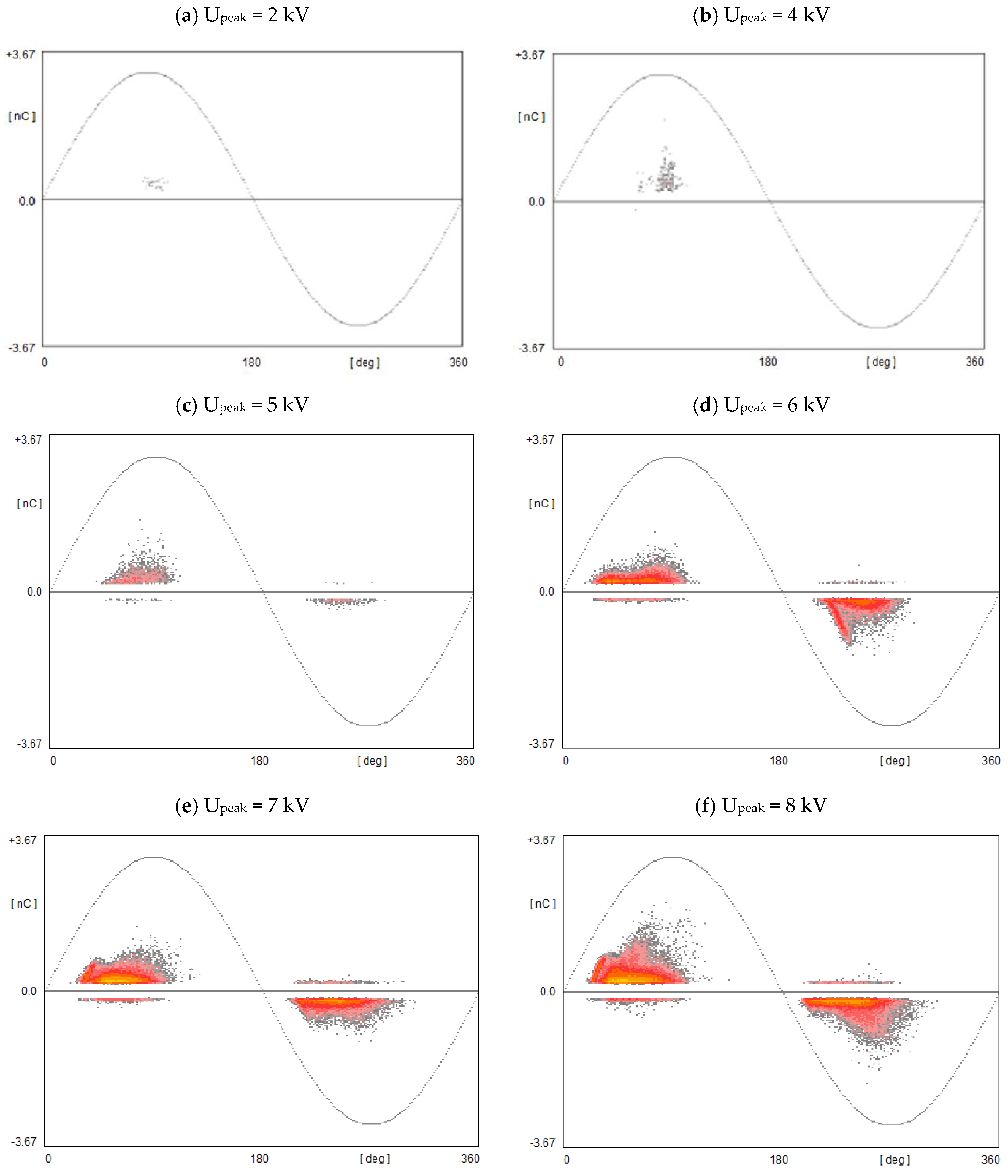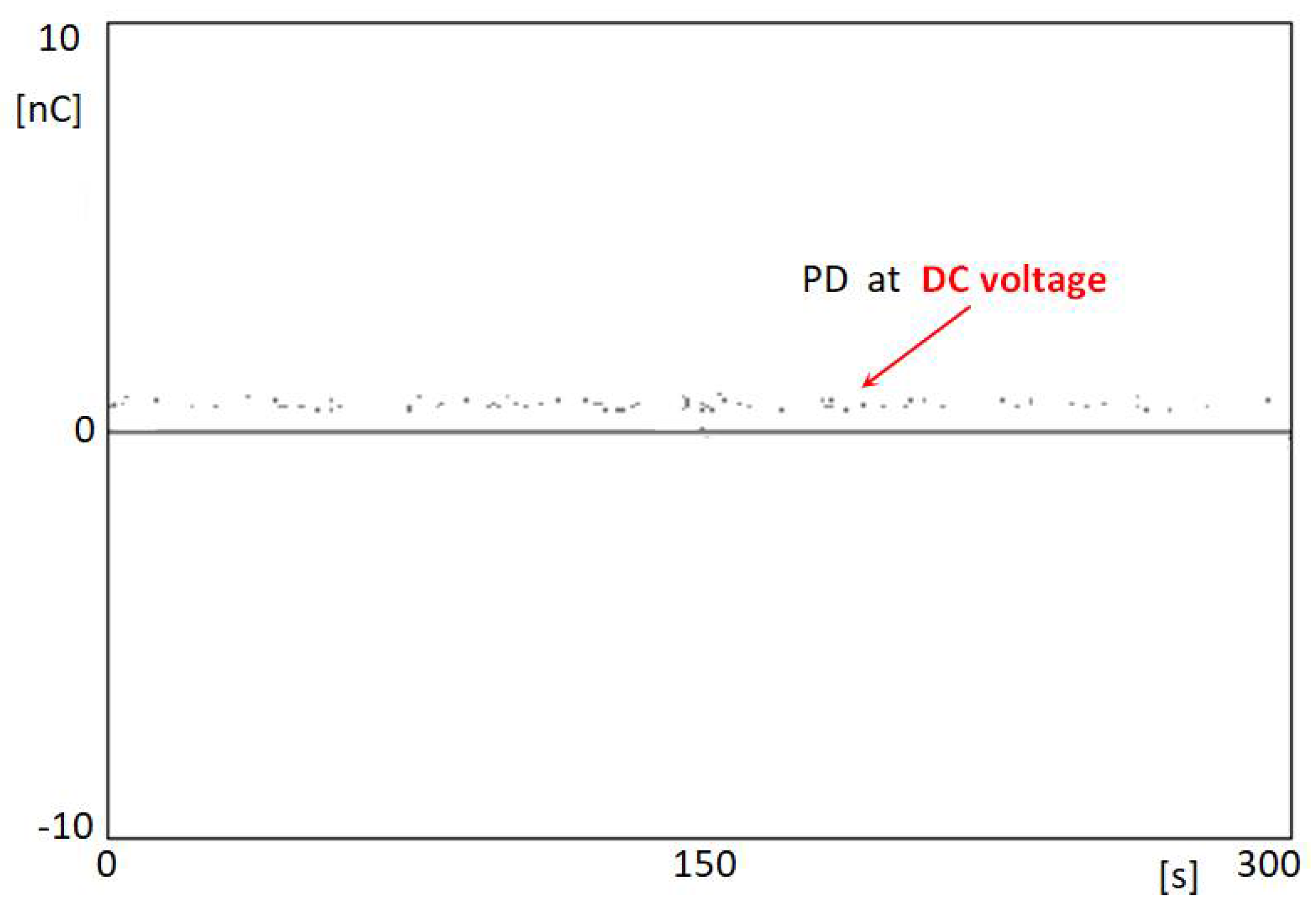Measurements and Analysis of Partial Discharges at HVDC Voltage with AC Components
Abstract
:1. Introduction
2. Methodology of Measurement
3. Measurement Setup and Test Specimen
4. Experimental Results
- (a)
- The DC voltage was set to 10 kV, the AC voltage component with frequency 50 Hz was superimposed on the DC, and the amplitude of the AC voltage was changed from the PD inception voltage to 8 kV.
- (b)
- The DC voltage was set to 10 kV, the AC harmonic with 6 kV amplitude was superimposed on the DC, and the frequency of the AC voltage component was set to: 50, 150, 300, and 350 Hz.
- (a)
- pure AC 50 Hz, U0 = 5 kV,
- (b)
- pure AC 300 Hz, U0 = 5 kV,
- (c)
- mixed DC 10 kV + AC 50 Hz 2 kV, U0 = 12 kV.
4.1. Acquisition of PDPD Patterns at Inception Voltage U0
4.2. PD at DC 10 kV + AC 50 Hz Upeak
4.3. PD at DC 10 kV + AC 6 kV, f [Hz]
5. Conclusions
Author Contributions
Funding
Institutional Review Board Statement
Informed Consent Statement
Data Availability Statement
Conflicts of Interest
References
- Jovcic, D.; Ahmed, K. High-Voltage Direct-Current Transmission. Converters, Systems and DC Grids; John Wiley & Sons: Hoboken, NJ, USA, 2015. [Google Scholar]
- Hammons, T.J.; Lescale, V.F.; Uecker, K.; Haeusler, M.; Retzmann, D.; Staschus, K.; Lepy, S. State of the art in ultrahigh-voltage transmission. Proc. IEEE 2012, 100, 360–390. [Google Scholar] [CrossRef]
- Debnath, S.; Qin, J.; Bahrani, B.; Saeedifard, M.; Barbosa, P. Operation, control, and applications of the modular multilevel converter: A review. IEEE Trans. Power Electron. 2015, 30, 37–53. [Google Scholar] [CrossRef]
- Kassakian, J.G.; Jahns, T.M. Evolving and emerging applications of power electronics in systems. IEEE J. Emerg. Sel. Top. Power Electron. 2013, 1, 47–58. [Google Scholar] [CrossRef]
- Tang, H.; Wu, G.; Chen, M.; Deng, J.; Li, X. Analysis and disposal of typical breakdown failure for resin impregnated paper bushing in the valve side of HVDC converter transformer. Energies 2019, 12, 4303. [Google Scholar] [CrossRef] [Green Version]
- Fard, M.A.; Farrag, M.E.; Reid, A.; Al-Naemi, F. Electrical treeing in power cable insulation under harmonics superimposed on unfiltered HVDC voltages. Energies 2019, 12, 3113. [Google Scholar] [CrossRef] [Green Version]
- Li, J.; Zhang, L.; Han, X.; Yao, X.; Li, Y. PD detection and analysis of oil-pressboard insulation under pulsed DC voltage. IEEE Trans. Dielectr. Electr. Insul. 2017, 24, 324–330. [Google Scholar] [CrossRef]
- Romano, P.; Imburgia, A.; Serdyuk, Y.; Ala, G.; Blennow, J.; Bongiorno, M.; Grasso, C.; Hammarström, T.; Rizzo, G. The Effect of the Harmonic Content Generated by AC/DC Modular Multilevel Converters on HVDC Cable Systems. In Proceedings of the 2019 IEEE Conference on Electrical Insulation and Dielectric Phenomena (CEIDP), Richland, WA, USA, 20–23 October 2019; pp. 666–669. [Google Scholar]
- Chen, G.; Hao, M.; Xu, Z.; Vaughan, A.; Cao, J.; Wang, H. Review of high voltage direct current cables. CSEE J. Power Energy Syst. 2015, 1, 9–21. [Google Scholar] [CrossRef]
- Doedens, E.; Jarvid, E.M.; Guffond, R.; Serdyuk, Y.V. Space charge accumulation at material interfaces in HVDC cable insulation Part I—Experimental study and charge injection hypothesis. Energies 2020, 13, 2005. [Google Scholar] [CrossRef] [Green Version]
- Doedens, E.; Jarvid, E.M.; Guffond, R.; Serdyuk, Y.V. Space charge accumulation at material interfaces in HVDC cable insulation Part II—Simulations of charge transport. Energies 2020, 13, 1750. [Google Scholar] [CrossRef] [Green Version]
- Gu, X.; He, S.; Xu, Y.; Yan, Y.; Hou, S.; Fu, M. Partial discharge detection on 320 kV VSC-HVDC XLPE cable with artificial defects under DC voltage. IEEE Trans. Dielectr. Electr. Insul. 2018, 25, 939–946. [Google Scholar] [CrossRef]
- Li, J.; Han, X.; Liu, Z.; Yao, X.; Li, Y. PD characteristics of oil-pressboard insulation under AC and DC mixed voltage. IEEE Trans. Dielectr. Electr. Insul. 2016, 23, 444–450. [Google Scholar] [CrossRef]
- Jacob, N.D.; McDermid, W.M.; Kordi, B. On-line monitoring of partial discharges in a HVDC station environment. IEEE Trans. Dielectr. Electr. Insul. 2012, 19, 925–935. [Google Scholar] [CrossRef]
- Fard, M.A.; Farrag, M.E.; McMeekin, S.G.; Reid, A. Partial discharge behaviour under operational and anomalous conditions in HVDC systems. IEEE Trans. Dielect. Electr. Insul. 2017, 24, 1494–1502. [Google Scholar] [CrossRef] [Green Version]
- From, U. Interpretation of partial discharges at dc voltages. IEEE Trans. Dielect. Electr. Insul. 1995, 2, 761–770. [Google Scholar] [CrossRef]
- Beroual, A.; Khaled, U.; Mbolo Noah, P.S.; Sitorus, H. Comparative study of breakdown voltage of mineral, synthetic and natural oils and based mineral oil mixtures under AC and DC voltages. Energies 2017, 10, 511. [Google Scholar]
- Sun, W.; Yang, L.; Zare, F.; Xia, Y.; Cheng, L.; Zhou, K. 3D modeling of an HVDC converter transformer and its application on the electrical field of windings subject to voltage harmonics. Electr. Power Energy Syst. 2020, 117, 105581. [Google Scholar] [CrossRef]
- Sarathi, R.; Oza, K.H.; Kumar, C.P.; Tanaka, T. Electrical treeing in XLPE cable insulation under harmonic AC voltages. IEEE Trans. Diel. Electr. Insul. 2015, 22, 3177–3185. [Google Scholar] [CrossRef]
- Li, G.; Liang, J.; Joseph, T.; An, T.; Lu, J.; Szechtman, M.; Andersen, B.R.; Zhuang, Q. Feasibility and reliability analysis of LCC DC grids and LCC/VSC Hybrid DC grids. IEEE Access 2019, 7, 22445–22456. [Google Scholar] [CrossRef]
- IEC 60270:2000+AMD1:2015 CSV; High-Voltage Test Techniques—Partial Discharge Measurements. International Electrotechnical Commission: Geneva, Switzerland, 2015.
- Morshuis, P.H.F.; Smit, J.J. Partial discharges at DC voltage: Their mechanism, detection and analysis. IEEE Trans. Dielectr. Electr. Insul. 2005, 12, 328–340. [Google Scholar] [CrossRef] [Green Version]
- Fard, M.A.; Reid, A.J.; Hepburn, D.M. Analysis of HVDC superimposed harmonic voltage effects on partial discharge behavior in solid dielectric media. IEEE Trans. Dielect. Electr. Insul. 2017, 24, 7–14. [Google Scholar] [CrossRef]
- Cavallini, A.; Montanari, G.C.; Tozzi, M.; Chen, X. Diagnostic of HVDC systems using partial discharges. IEEE Trans. Dielectr. Electr. Insul. 2011, 18, 275–284. [Google Scholar] [CrossRef]
- Florkowski, M. Influence of high voltage harmonics on partial discharge patterns. In Proceedings of the 5th International Conference on Properties and Applications of Dielectric Materials, Seoul, Korea, 25–30 May 1997. [Google Scholar]
- Florkowski, M.; Florkowska, B. Distortion of partial-discharge images caused by high-voltage harmonics, IEE Proceedings—Generation. Transm. Distrib. 2006, 153, 171–180. [Google Scholar] [CrossRef]
- Florkowski, M.; Florkowska, B.; Furgał, J.; Zydron, P. Impact of high voltage harmonics on interpretation of partial discharge patterns. IEEE Trans. Dielectr. Electr. Insul. 2013, 20, 2009–2016. [Google Scholar] [CrossRef]
- Florkowski, M.; Kuniewski, M.; Zydron, P. Partial Discharges in HVDC Insulation with Superimposed AC Harmonics. IEEE Trans. Dielectr. Electr. Insul. 2020, 27, 1906–1914. [Google Scholar] [CrossRef]
- Florkowski, M. Observations of Partial Discharge Echo in Dielectric Void by Applying a Voltage Chopped Sequence. Energies 2018, 11, 2518. [Google Scholar] [CrossRef] [Green Version]
- Romano, P.; Presti, G.; Imburgia, A.; Candela, R. A new approach to partial discharge detection under DC voltage. IEEE Electr. Insul. Mag. 2018, 34, 32–41. [Google Scholar] [CrossRef]
- Imburgia, A.; Rizzo, G.; Romano, P.; Ala, G.; Candela, R. Time evolution of partial discharges in a dielectric subjected to the DC periodic voltage. Energies 2022, 15, 2052. [Google Scholar] [CrossRef]
- Kuffel, J.; Zaengl, W.S.; Kuffel, P. High Voltage Engineering Fundamentals, 2nd ed.; Newnes: Oxford, UK, 2000; ISBN 978-0-7506-3634-6. [Google Scholar]






Publisher’s Note: MDPI stays neutral with regard to jurisdictional claims in published maps and institutional affiliations. |
© 2022 by the authors. Licensee MDPI, Basel, Switzerland. This article is an open access article distributed under the terms and conditions of the Creative Commons Attribution (CC BY) license (https://creativecommons.org/licenses/by/4.0/).
Share and Cite
Florkowski, M.; Kuniewski, M.; Zydroń, P. Measurements and Analysis of Partial Discharges at HVDC Voltage with AC Components. Energies 2022, 15, 2510. https://doi.org/10.3390/en15072510
Florkowski M, Kuniewski M, Zydroń P. Measurements and Analysis of Partial Discharges at HVDC Voltage with AC Components. Energies. 2022; 15(7):2510. https://doi.org/10.3390/en15072510
Chicago/Turabian StyleFlorkowski, Marek, Maciej Kuniewski, and Paweł Zydroń. 2022. "Measurements and Analysis of Partial Discharges at HVDC Voltage with AC Components" Energies 15, no. 7: 2510. https://doi.org/10.3390/en15072510







